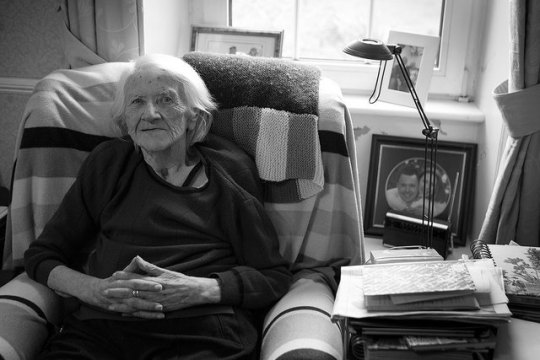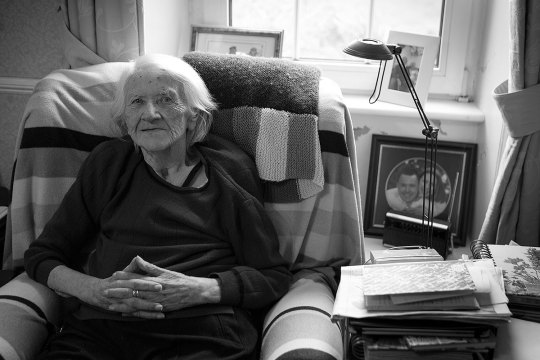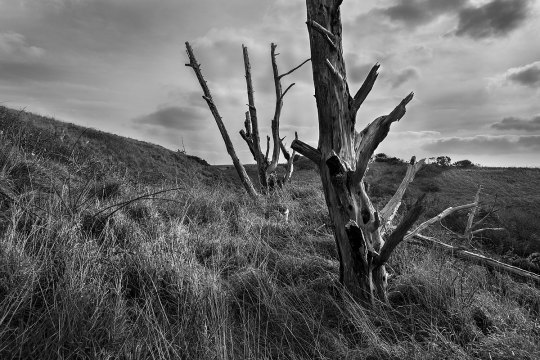#Joyce Brideaux
Photo

Joyce Gilbert
1926 — 2017
It’s with great sadness that I’ve learned of the passing of Joyce Gilbert (née Brideaux) in St. Martin, Bailiwick of Jersey, on October 22.
Joyce was the last Brideaux born a Brideaux living in Jersey. She was the daughter of Herbert Brideaux (son of Elias Jean, son of Elias Jean) and Laura Renouf.
Joyce, along with her late husband Brian Gilbert, were pillars of l'Assemblee du Jèrriais and active in promoting and preserving the Jèrriais language. Joyce is also responsible for most of the ancestral research available on the Brideauxs in Jersey. I’ll be forever grateful of her legacy.
0 notes
Photo


The First and The Last
I’m standing on a tract of land on the windswept northwest bluffs of the Bailiwick of Jersey, called Les Vaux Brideaux. It’s a small valley leading down from potato fields to the flat farmlands along the coast of St. Ouen’s Bay. It’s a surreal moment, because I’m researching my ancestors in Jersey, and this tract of land is where it all began.
The land appears to be associated with Pierre Brideaux, who barely appears in the island records, noted only as the father of his son, also named Pierre (1645-1682). Pierre the younger was born during the English Civil War, when Cromwell’s New Model Army battled Royalist forces in England. The Channel Islands in no way escaped the conflict, so Pierre the elder lived in interesting times.
Pierre the elder has no apparent baptism record in Jersey, and may have come from France, making him quite possibly the first Brideaux in Jersey. His descendants would increasingly migrate outwards across the island and then around the world. Three hundred and seventy-one years and thirteen generations of Brideauxs later, I’m stepping back onto this point of origin. And I’m thinking about my meeting the previous day with the last living Brideaux in Jersey.
“I am the only survivor of the Pierre Brideaux who came here in the 1600s,” declares Joyce Brideaux, during my visit the previous day. At 95 years old, she is the last Brideaux born a Brideaux — living here, where it all began.
I only find out about Joyce on my last day on the island during my February 2015 visit. Her husband Brian has recently passed away. Her daughter Glenda phones BBC Jersey to track me down after hearing me interviewed about my ancestral research, and my interest in the surviving Jèrriais community. Now another year has passed before I’m able to return and visit her, and I’m relieved that I can.
As I’m ushered in to meet her in the sitting room of a large house in St. Martin Parish, I can’t help but feel a sense of awe. She is my oldest living relative. She is responsible for the most comprehensive accounting of the Brideaux family to date, found online in Jerripedia. She was a pillar of l'Assemblée d'Jèrriais for many years along with her husband. She was born in 1921, the year my grandfather left the bailiwick for Canada. And she has the aura and the countenance of a genuine Jèrriais elder.
Joyce has lived in St. Martin Parish since 1949, when she married Brian Gilbert. They farmed for a number of years before becoming produce wholesalers. By 1960 they had more time to themselves, which is when they joined l'Assemblée d'Jèrriais — because, of course, they spoke Jèrriais.
“I have always spoken it from the cradle,” she says. “When I first started speaking, it was in Jèrriais, and my maternal grandfather — who was a great speaker — he was a Renouf, and he spoke nothing else but Jèrriais all his life. He wasn’t interested in English. Even though he was a good churchman, and went and read lessons at church, when he was speaking to anyone he always spoke in Jèrriais. My father, my grandfather, my mother and my grandmother, they were all Jèrriais people. Therefore we spoke Jèrriais all the time. My father-in-law spoke very good Jèrriais, but it was Jèrriais from La Rocque. And it wasn’t the same as the Jèrriais that we used to speak at St. John’s.”
Jèrriais has its own varieties?
“Oh, very much so,” she says. ”St. Ouen’s has its own accent. La Moye, St. Brelade’s, has got an accent as well. And La Rocque has different words for different articles, and different things or places. Town [St. Helier], of course, doesn’t speak Jèrriais, only what they’ve learned out of books. And it’s not the same thing. But St. Peter’s, St. Mary’s, St. John’s, St. Lawrence, and Trinity are very much the same. St. Martin’s, a little bit different, but not much. St. Saviour’s doesn’t speak Jèrriais. And St. Clement’s, very little.”
Joyce was fortunate to have both the language spoken in her home as well as in her school. This was not the norm for many Jèrriais-speaking families challenged by the growth of an Anglophone public sphere on the island.
“I was lucky. In the 1930s, when you went to school, it was frowned upon to talk in Jèrriais, because most of the teachers were English and they couldn’t understand what you were saying. So, if you were talking to somebody else in the playground or in school, and you spoke in Jèrriais, they didn’t know if you were talking about them. And so they said they didn’t want to have any Jèrriais spoken in the school, and that put a damper a bit on the Jèrriais. But for me, my teacher was from St. Ouen’s, and we always used to converse in Jèrriais. I used to go on the bus, and she was on the same bus as I was, going to school. So we always had a good chat in Jèrriais, and I never lost my Jèrriais.”
So it’s little surprise that Joyce and her husband Brian later became prominent members of l'Assemblée d'Jèrriais. They worked hard in maintaining the links forged by Norman speakers across the Channel Islands and mainland France.
“After Brian and I joined l'Assemblée in 1960, Brian became President of one department of l'Assemblée, and I became the secretary there. And then later he became the President of the whole committee, and I became the secretary for that. We used to go to the annual general meetings where he’d chair the AGM and I’d read out the minutes of the whole year. We had a great time, we traveled a lot in Normandy and saw our Normandy cousins. And we always went to Guernsey for their lunches and dinners. Brian used to have to speak in Jersey French, and of course the Guernsey people had to speak in Guernsey French, so we came to understand each other very well.”
Their travels on mainland France, both for l'Assemblée and for leisure, gave them opportunities to introduce Jèrriais to people who had no more heard of Jersey French than the many British who regularly vacationed on Jersey’s beaches. And to have some fun with that.
“Quite often we were in a restaurant, and we would start talking in Jèrriais. And of course all the tables around us would stop to listen because French people couldn’t make out which department of France we came from. And they used to say, ‘Oh, they must come from the south?’ And then they’d say, ‘No they can’t come from the south, because they don’t pronounce the end of their words. They don’t pronounce the t’s.’ Then the next day, if we went to breakfast or something, we’d be speaking in English, and then they’d say, ‘Well that was a funny language they spoke yesterday but they can still speak English just the same.’ Ah, we used to run them! Joke with them all over the place. It was great fun to do that.”
If Joyce is the last Brideaux, what happened to all the rest?
It seems they’ve all left the island or passed on. Some settled in Quebec. Others left and settled in Wales or New England. Joyce’s clan, possibly the largest clan of Brideauxs ever seen on the island, mostly left too. Her grandfather, Elias Jean Brideaux (1849-1908) had fourteen children, of which her father (Philip Herbert) was the second youngest. Elias Jean, who was a school attendance officer, sent his sons away one by one as they came of age, and insisted that they make their own fortune somewhere in the world. No one came back, but these expatriates are why Brideauxs are now to be found everywhere else.
“Uncle Walter and Uncle Fred went to America. Uncle Edwin went to Canada. Uncle Winter went to India. Uncle William to South Africa. Uncle Arthur went to St. Malo [France] and died there,” says Joyce, accounting for some of them.
And it turns out that I’m not the first Philip Brideaux to make a pilgrimage back to the homeland.
Edwin Brideaux, her uncle who went to Canada, settled in Sault Ste. Marie, Ontario and married Phyllis Chestle. His youngest son was Philip John Brideaux (coincidentally the same name as my great grandfather). Philip and his wife Marilyn, along with his mother, visited Jersey before me decades ago, and met with Joyce.
On that trip, says Joyce, they went to St. Ouen Parish to visit the remains of L’Amiral, the oldest known manor of the Brideaux family. It was passed down through the generations, though from how far back, she does not know. The second volume of Jersey Placenames (Stevens and Stevens, Société Jersiaise, 1986) suggests it previously belonged to the Le Brocq family but perhaps doesn’t seem to have become a Brideaux homestead until sometime after 1754. Her grandfather Elias Jean bequeathed it to his eldest son Alfred, who bequeathed it to his younger son, Lewis. After the Second World War, Lewis was living in England, and sold the manor out of the Brideaux family. When Philip and his family came from Sault Ste. Marie, Ontario, and visited the property with Joyce and Brian, they found only ruins.
I say goodbye to Joyce, and the next day I visit L’Amiral with my friend Estelle Bisson, from the Jersey Archives. A contractor working on the property takes me around behind a garage. He points at a slice of crumbled wall, overgrown with vines. It is all that remains of the manor. The property has long since been redeveloped for subsequent owners.
So I leave L’Amiral and soon find myself standing in Les Vaux Brideaux. To the east lay fields of Jersey Royals and St. Ouen’s Windmill. To the west is St. Ouen’s Bay and the English Channel. The wind is so strong I can hear nothing else.
The gravity of the moment has me thinking about the Buddhist teacher Thich Nhat Hanh, who explains that we are continued by our children. “You are in here, you are in him. You have transmitted yourself entirely to him or to her. Your son is a continuation of you. Your daughter is a continuation of you. Your son is you. Your daughter is you. And they will carry you far into the future,” he says.
There is no clear record of whom Pierre Brideaux the elder married, but that union has carried them over 370 years into the future. Pierre Brideaux has been continued by Pierre the younger and his siblings. Pierre Brideaux is continued in Joyce Brideaux, and Joyce Brideaux is an oracle who points the way back to Pierre. Joyce’s contribution to the preservation of Jersey’s heritage and language, as well as her family research, is a great, glowing node in the vast network of continuance spreading out from Pierre. Joyce is the invaluable gift I have had in this search. Because of her, I know that I am the great great great great great great great great great great grandson of Pierre, and so he is continued in me, just as he is continued in my youngest, closest relative, my nephew Noa.
But who was Pierre? To find that out, I have to follow the wind back from where it came. It whips furiously across the tall, wild, grass of Les Vaux Brideaux and whistles through the silvery skeletal remains of the ancient trees.
#Les Vaux Brideaux#Joyce Brideaux#Pierre Brideaux#Jersey#JerseyCI#jersey channel islands#heritage jersey#jersey heritage#st martin parish#st ouen#st ouen parish#jerriais#Jèrriais#heritagejersey#jerseychannelislands#jerseyproject#jersey placenames
0 notes